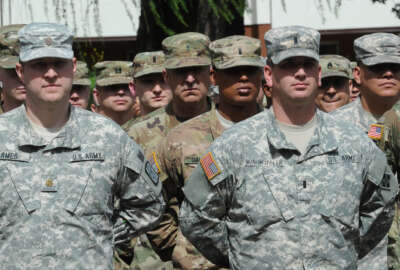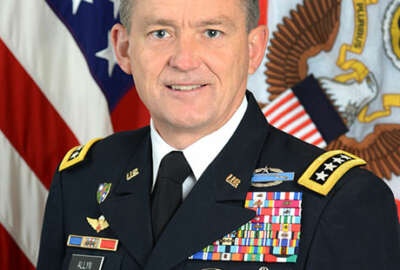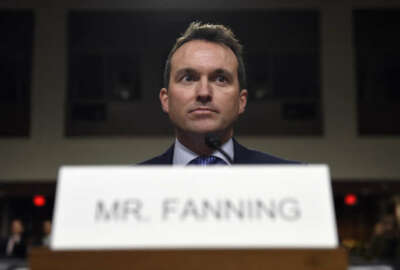
Exclusive
Army looking at creating deployment pay to keep soldiers in shape
To combat the Army's nondeployability problem, the service wants to add deployment pay and cut tuition assistance for non-deployable soldiers.
Subscribe to Federal Drive’s daily audio interviews on iTunes or PodcastOne
As the Army prepares for the possibility of growing its end strength in 2018, the issue of non-deployable soldiers is once again at the forefront of military officials’ minds.
About 100,000 soldiers are currently non-deployable in the Army, meaning they cannot fill their position and perform the task for which they were enlisted.
But the Army has a few ideas on how to change that.
The Army is considering creating deployment pay for soldiers, Sgt. Maj. of the Army Daniel Dailey told Federal News Radio in an exclusive interview.
“We have to stimulate their responsibility. It’s a soldier’s responsibility to maintain deployability. They all raised their hands, including me, and swore they will defend the Constitution of the United States of America. That didn’t mean back in the U.S. That means wherever the Constitution needs to be defended. We have to encourage soldiers,” Dailey said. “We should tie all incentives to deployability. Soldiers who deploy should make more money. We should have a deployment pay and that’s something we are working on right now.”
Dailey said the privileges awarded to soldiers should be contingent on their deployability.
“The great gifts we get from the American taxpayers should all be applied to deployability. Things like tuition assistance. You should not be able to use tuition assistance unless you are deployable. It is for a readiness requirement. It is to support our soldiers and retain our soldiers over time. It is not a right,” Dailey said.
Soldiers already receive some extra pay when they are deployed, but those payments are based on hazards or are set allowances.
For example, service members are given more pay if they are subjected to hostile fire. That pay is also tax exempt.
Dailey said in 2015 that nondeployable soldiers were the number one problem in the Army.
“If you will not or cannot fight and win, then there’s no place for you in the Army,” Dailey said. “We have to become unemotional about this. We have a job to do.”
What’s concerning for the Army is only 10 percent of its non-deployable soldiers will ever be fit to serve again. Last year, then-Vice Army Chief of Staff Gen. Daniel Allyn said only a small number of non-deployable troops are able to get back to deployable status.
Allyn said the Army can do a much better job in speeding up the recuperation of the 10,000 troops that can become deployable again.
Latest Army News
About 80 percent of non-deployable troops reached that status due to medical issues, Allyn said.
“We know that we can gain efficiency in terms of speed with which we transition these folks, either back to full readiness or to another phase,” Allyn said. “We have to work with the [Department of Veterans Affairs] on the vast majority of the rest of them to ensure we transition them to [VA] care as efficiently and effectively as possible.”
Part of the reason for the high number of non-deployable soldiers is the rate of obesity in the Army. Soldiers are required to stay between 20 percent and 26 percent body fat for men and 30 percent and 36 percent body fat for women.
More than 10 percent of the service is overweight, deeming them unfit to deploy.
The Army is trying to shore up some of its injury and health problems through a new Occupational Physical Assessment Test. The test is part of the recruiting process and determines if the recruit meets the physical demands consistent with a soldier’s specialty.
Leader of U.S. Army Recruiting Command Maj. Gen. Jeffrey Snow said before the test was implemented the Army was losing 11 percent to 12 percent of its recruits in basic training alone.
The test also helps the Army figure out if someone needs more training or specific work to reach his or her desired specialty.
“If this works the way it’s designed to work, we should see a decline in attrition,” Snow said.
The Army also wants to make sure it keeps the right people in the service as it grows. Dailey said the Army met its goal of expanding to 1.18 million by September 2017.
“We met [the goal] with all the same quality measures that we had the previous years and the years before. That’s not something we did in the growth years in the height of surge in Iraq and Afghanistan. We lowered some of those requirements and we learned from that. It’s important we keep our eye on those standards because it’s not about numbers. Making end strength means nothing if we don’t have soldiers who are fully capable to fight and win our nation’s wars,” Dailey said.
Copyright © 2025 Federal News Network. All rights reserved. This website is not intended for users located within the European Economic Area.
Scott Maucione is a defense reporter for Federal News Network and reports on human capital, workforce and the Defense Department at-large.
Follow @smaucioneWFED





